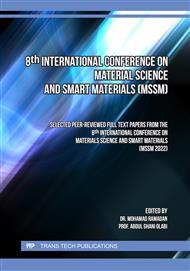[1]
Information on https://datatopics.worldbank.org/what-a-waste/trends_in_solid_waste_ management.html, The World Bank, Trends in Solid Waste Management. [Accessed 06 June 2022].
Google Scholar
[2]
Information on https://www.czso.cz/documents/10180/61546956/28002018.pdf/36b79716-4bee-4e66-96b8-0298993b2276?version=1.3, CZSO - Czech Statistical Office, Generation, Recovery and Disposal of Waste for the period 2017, [Accessed 16 June 2022].
Google Scholar
[3]
M.T. Maw and D. Juchelková, Drying methods for municipal solid waste quality improvement in the developed and developing countries: A review, in Environmental Engineering Research, vol. 24, no. 4, pp.529-542. (2019)
DOI: 10.4491/eer.2018.327
Google Scholar
[4]
R. N. Hunter, A. Self and J. Read, The Shell Bitumen Handbook Sixth Edition, London, UK: Shell Bitumen by ICE Publishing. (2015)
Google Scholar
[5]
European Parliament News, Plastic waste and recycling in the EU: facts and figures. (2018)
Google Scholar
[6]
A. Almeida, S. Capitão, R. Bandeira, M. Fonseca and L. Picado-Santos, "Performance of AC mixtures containing flakes of LDPE plastic film collected from urban waste considering ageing, Construction and Building Materials, vol. 232, p.117253. (2020)
DOI: 10.1016/j.conbuildmat.2019.117253
Google Scholar
[7]
D. N. Little, Enhancement of asphalt concrete mixtures to meet structural requirements through the addition of recycled polyethylene, ASTM Special Technical Publication 1193, pp.210-210. (1993)
DOI: 10.1520/stp19852s
Google Scholar
[8]
M. Panda and M. Mayajit, Utilization of reclaimed polyethylene in bituminous paving mixes, Journal of materials in civil engineering, vol. 16, no. 6, pp.527-530. (2002)
DOI: 10.1061/(asce)0899-1561(2002)14:6(527)
Google Scholar
[9]
M. T. Awwad and L. Shbeeb, The Use of Polyethylene in Hot Asphalt Mixtures, American Journal of Applied Sciences, vol. 4, no. 6, pp.390-396. (2007)
DOI: 10.3844/ajassp.2007.390.396
Google Scholar
[10]
V. Punith and A. J. J. O. M. I. C. E. Veeraragavan, Behavior of asphalt concrete mixtures with reclaimed polyethylene as additive, Journal of materials in civil engineering, vol. 19, no. 6, pp.500-507. (2007)
DOI: 10.1061/(asce)0899-1561(2007)19:6(500)
Google Scholar
[11]
A.M. Othman, Effect of Low-Density Polyethylene on Fracture Toughness of Asphalt Concrete Mixtures, Journal of Materials in Civil Engineering, vol. 22, no. 10, pp.1019-1024. (2010)
DOI: 10.1061/(asce)mt.1943-5533.0000106
Google Scholar
[12]
J. Martin-Alfonso, A. Cuadri, J. Torres, M. Hidalgo and P. Partal, Use of plastic wastes from greenhouse in asphalt mixes manufactured by dry process, Road Materials and Pavement Design, vol. 20, no. sup1, pp. S265-S281. (2019)
DOI: 10.1080/14680629.2019.1588776
Google Scholar
[13]
H. Yu, Z. Zhu, Z. Zeyu, J. Yu, M. Oeser and D. Wang, Recycling waste packaging tape into bituminous mixtures towards enhanced mechanical properties and environmental benefits, Journal of Cleaner Production, vol. 229, pp.22-31. (2019)
DOI: 10.1016/j.jclepro.2019.04.409
Google Scholar
[14]
M. Daryl, S. Ho, R. Wirth and L. Zanzotto, Study of crumb rubber materials as paving asphalt modifiers, Canadian Journal of Civil Engineering, vol. 34, no. 10, pp.1276-1288. (2007)
DOI: 10.1139/l07-056
Google Scholar
[15]
P. Cong, P. Xun, M. Xing and S. Chen, Investigation of asphalt binder containing various crumb rubbers and asphalts, Construction and Building Materials, vol. 40, pp.632-641. (2013)
DOI: 10.1016/j.conbuildmat.2012.11.063
Google Scholar
[16]
T. Ma, H. Wang, L. He, Y. Zhao, X. Huang and J. Chen, Property characterization of asphalt binders and mixtures modified by different crumb rubbers, Journal of Materials in Civil Engineering, vol. 29, no. 7, p.04017036. (2017)
DOI: 10.1061/(asce)mt.1943-5533.0001890
Google Scholar
[17]
M. Zaumanis, R. B. Mallick, L. Poulikakos and R. Frank, Influence of six rejuvenators on the performance properties of Reclaimed Asphalt Pavement (RAP) binder and 100% recycled asphalt mixtures, Construction and Building Materials, vol. 71, pp.538-550. (2014)
DOI: 10.1016/j.conbuildmat.2014.08.073
Google Scholar
[18]
M. Zaumanis, R. B. Mallick and R. Frank, Evaluation of different recycling agents for restoring aged asphalt binder and performance of 100 % recycled asphalt, Materials and Structures, vol. 48, p.2475–2488. (2015)
DOI: 10.1617/s11527-014-0332-5
Google Scholar
[19]
D. Daryaee, M. Ameri and A. Mansourkhaki, Utilizing of waste polymer modified bitumen in combination with rejuvenator in high reclaimed asphalt pavement mixtures, Construction and Building Materials, vol. 235, p.117516. (2020)
DOI: 10.1016/j.conbuildmat.2019.117516
Google Scholar
[20]
H. Asli, E. Ahmadinia, M. Zargar and M. R. Karim, Investigation on physical properties of waste cooking oil – Rejuvenated bitumen binder, Construction and Building Materials, vol. 37, pp.398-405. (2012)
DOI: 10.1016/j.conbuildmat.2012.07.042
Google Scholar
[21]
S.-C. Huang, Q. Qin, W. Grimes, A. Pauli and R. Glaser, Influence of rejuvenators on the physical properties of RAP binders, Journal of Testing and Evaluation, vol. 43, no. 3, pp.594-603. (2015)
DOI: 10.1520/jte20130314
Google Scholar
[22]
A. I. Al-Hadidy and T. Yi-qiu, Effect of polyethylene on life of flexible pavements, Construction and Building Materials, vol. 23, no. 3, pp.1456-1464. (2009)
DOI: 10.1016/j.conbuildmat.2008.07.004
Google Scholar
[23]
F. Xiao and S. N. Amirkhanian, Laboratory investigation of moisture damage in rubberised asphalt mixtures containing reclaimed asphalt pavement, International Journal of Pavement Engineering, vol. 10, no. 5, pp.319-328. (2009)
DOI: 10.1080/10298430802169432
Google Scholar



